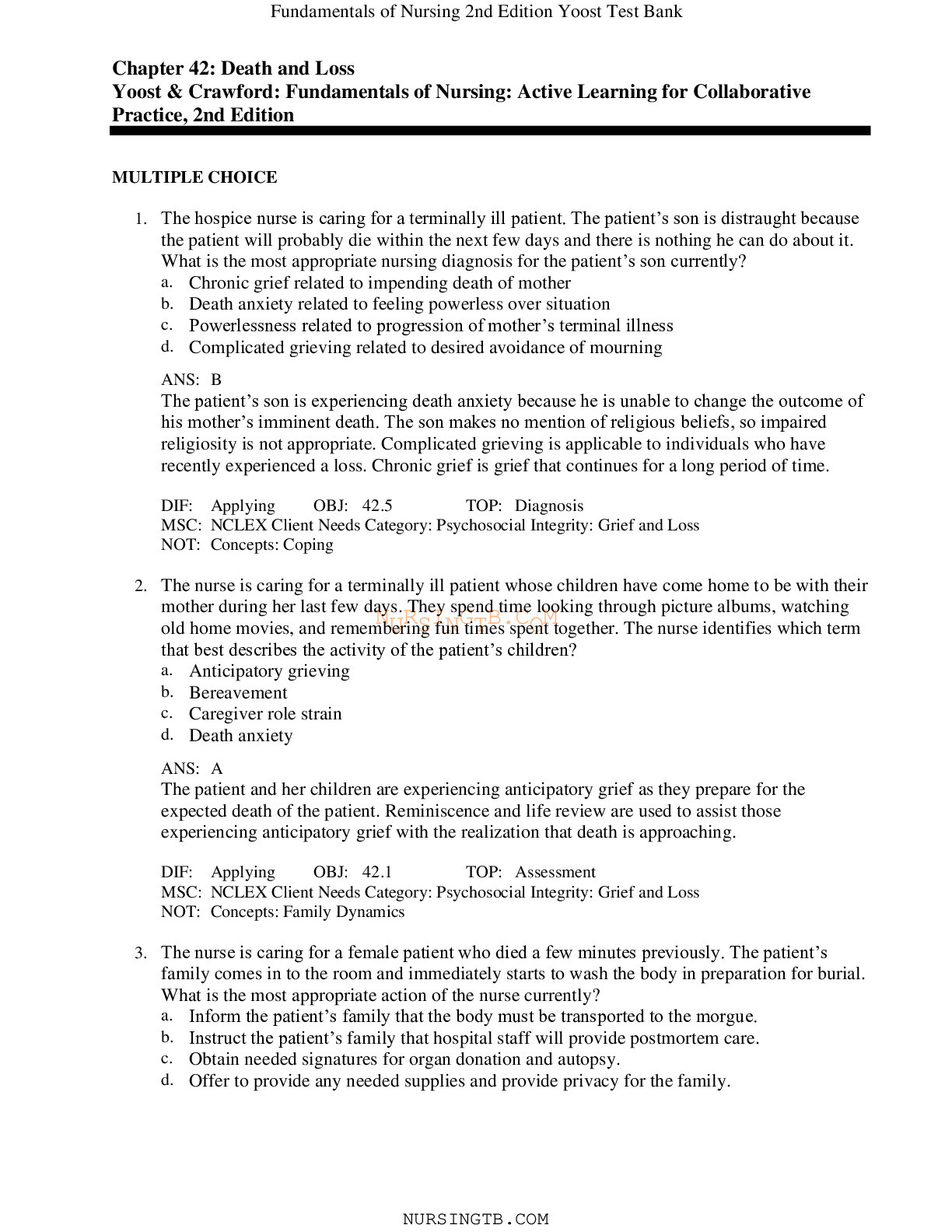All study resources > Chapter 42: Death and Loss Yoost & Crawford: Fundamentals of Nursing: Active Learning for Collaborative Practice, 2nd Edition (Nursing)
Chapter 42: Death and Loss Yoost & Crawford: Fundamentals of Nursing: Active Learning for Collaborative Practice, 2nd Edition
1. The hospice nurse is caring for a terminally ill patient. The patient’s son is distraught because
the patient will probably die within the next few days and there is nothing he can do about it.
What is the most appropriate nursing diagnosis for the patient’s son currently?
a. Chronic grief related to impending death of mother
b. Death anxiety related to feeling powerless over situation
...[Show More]
1. The hospice nurse is caring for a terminally ill patient. The patient’s son is distraught because
the patient will probably die within the next few days and there is nothing he can do about it.
What is the most appropriate nursing diagnosis for the patient’s son currently?
a. Chronic grief related to impending death of mother
b. Death anxiety related to feeling powerless over situation
c. Powerlessness related to progression of mother’s terminal illness
d. Complicated grieving related to desired avoidance of mourning
2. The nurse is caring for a terminally ill patient whose children have come home to be with their
mother during her last few days. They spend time looking through picture albums, watching
old home movies, and remembering fun times spent together. The nurse identifies which term
that best describes the activity of the patient’s children?
a. Anticipatory grieving
b. Bereavement
c. Caregiver role strain
d. Death anxiety
3. The nurse is caring for a female patient who died a few minutes previously. The patient’s
family comes in to the room and immediately starts to wash the body in preparation for burial.
What is the most appropriate action of the nurse currently?
a. Inform the patient’s family that the body must be transported to the morgue.
b. Instruct the patient’s family that hospital staff will provide postmortem care.
c. Obtain needed signatures for organ donation and autopsy.
d. Offer to provide any needed supplies and provide privacy for the family.
4. The nurse is caring for an emergency room patient who died because of a mishap with a
loaded gun. The patient’s body will be transported to the coroner’s office for an autopsy.
Which items will the nursing staff remove from the body before it leaves the hospital?
a. Endotracheal tube
b. Foley catheter and IV line
c. Dentures
d. Necklace and watch
5. The nurse is caring for a patient who suffered a miscarriage at 24 weeks of pregnancy. The
patient is devastated by the loss but her husband minimizes her grief by stating, “Quit crying.
It’s not like you lost a real baby.” What term best describes the anguish felt by the patient?
a. Disenfranchised grief
b. Delayed grief
c. Moral distress
d. Masked grief
6. A patient has recently been given a terminal diagnosis. When family members offer to help,
the patient snaps and yells at them, but then angrily accuses them of not helping. The patient’s
spouse is frustrated and asks the hospice nurse what to do about this situation. What response
by the nurse is best?
a. “Don’t worry. Your spouse will get over this phase soon.”
b. “Anger is an expected part of the grieving process.”
c. “Would your spouse be open to professional counseling?”
d. “This diagnosis is difficult to handle; just be patient.”
[Show Less]
